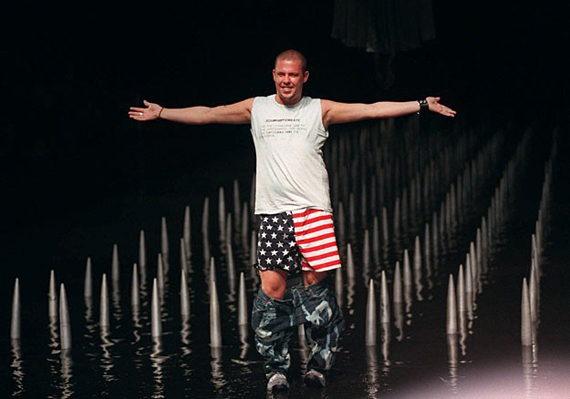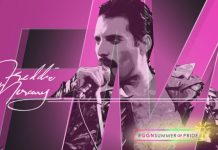
MCQUEEN MUSTS :: There’s no end for our admiration for the late great queer fashion designer Alexander McQueen (last year’s biography on McQueen, Blood Beneath The Skin is a must-read for any fashion fan). Peter J. Read is one such fan – and aspiring fashion historian. He has curated this McQueen Must List:
MCQUEEN MUSTS :: There’s no end for our admiration for the late great queer fashion designer Alexander McQueen (last year’s biography on McQueen, Blood Beneath The Skin is a must-read for any fashion fan). Peter J. Read is one such fan – and aspiring fashion historian. He has curated this McQueen Must List:
1. McQueen was obsessed with Scotland and its history, basing two collections on it: “I know a lot about Scotland, my mother was a genealogist and know my family tree, my dynasty”.
2. McQueen’s collections were autobiographical, not designed for the masses, but for himself: “My collections have a lot to do with my sexuality and coming to terms with the person I am and often releasing old ghosts through them”.
3. McQueen looked at death as not only melancholic but also romantic: “Death is the end of a cycle. The cycle of life is positive as it makes way for new things”.
4. Aside from McQueen’s dark character, there was a truly romantic person who dreamed about looking for love, and his ideas on the subject of love were above and beyond reality (often leaving him emotionally deflated): “Life is like a bit of a Grimm’s fairy tale”.
5. McQueen was not at ease in most social situations, not knowing what was or was not appropriate. His fragility was very obvious despite his bravado and this sensitive side made life difficult for McQueen. A close friend said of him, ” Lee is like a closed up shop and there was only a few people he was willing to listen to and trust, often isolating himself. He hated is celebrity, the pressure of fame, and having to put himself on the line and having to expose the personal details of his life”.
6. McQueen carried a lot of guilt over the death of his friend and mentor, Isabella Blow, “a cross between a Billingsgate fisherman’s wife and Lucretia Borgia” and dedicated his Spring/Summer 2008 collection to Blow calling it “Le Dame Bleu”.
7. McQueen was fascinated with winged creatures, which stemmed back to his early youth and were often prominent in his collections. He said, “Birds in flight fascinate me. I admire eagles and falcons, I’m inspired by a feather, its colour, graphics and weightlessness. They’re so elaborate, in fact I transport the beauty of the bird to women”.
8. He maintained the art of fashion design was similar to the process of plastic surgery saying, “With me metamorphosis is a bit like plastic surgery, but less drastic. I try to have the same effect with my clothes, but ultimately I try to transform mentalities more than I do the bodies, I try to modify fashion like a surgeon by offering what is relevant today and what will be tomorrow”.
9. Themes of beauty were central to his vision of fashion, which often reflected on the politics of appearance, both the prejudices and limitations of our aesthetic judgement. McQueen believed in the power of love to transform something ugly in to something beautiful; it was critical to his creative process. He went as so far as having the lovesick Helena’s soliloquy from Shakespeare’s Midsummer’s Night Dream tattooed on his arm, which read, “Love looks not with the eyes but the mind”.
– Peter J. Read is a third year Fashion Communications student and aspiring fashion historian. He is a true blue fashionista who lives and breathes fashion and its many facets.
1. McQueen was obsessed with Scotland and its history, basing two collections on it: “I know a lot about Scotland, my mother was a genealogist and know my family tree, my dynasty”.
2. McQueen’s collections were autobiographical, not designed for the masses, but for himself: “My collections have a lot to do with my sexuality and coming to terms with the person I am and often releasing old ghosts through them”.
3. McQueen looked at death as not only melancholic but also romantic: “Death is the end of a cycle. The cycle of life is positive as it makes way for new things”.
4. Aside from McQueen’s dark character, there was a truly romantic person who dreamed about looking for love, and his ideas on the subject of love were above and beyond reality (often leaving him emotionally deflated): “Life is like a bit of a Grimm’s fairy tale”.
5. McQueen was not at ease in most social situations, not knowing what was or was not appropriate. His fragility was very obvious despite his bravado and this sensitive side made life difficult for McQueen. A close friend said of him, ” Lee is like a closed up shop and there was only a few people he was willing to listen to and trust, often isolating himself. He hated is celebrity, the pressure of fame, and having to put himself on the line and having to expose the personal details of his life”.
6. McQueen carried a lot of guilt over the death of his friend and mentor, Isabella Blow, “a cross between a Billingsgate fisherman’s wife and Lucretia Borgia” and dedicated his Spring/Summer 2008 collection to Blow calling it “Le Dame Bleu”.
7. McQueen was fascinated with winged creatures, which stemmed back to his early youth and were often prominent in his collections. He said, “Birds in flight fascinate me. I admire eagles and falcons, I’m inspired by a feather, its colour, graphics and weightlessness. They’re so elaborate, in fact I transport the beauty of the bird to women”.
8. He maintained the art of fashion design was similar to the process of plastic surgery saying, “With me metamorphosis is a bit like plastic surgery, but less drastic. I try to have the same effect with my clothes, but ultimately I try to transform mentalities more than I do the bodies, I try to modify fashion like a surgeon by offering what is relevant today and what will be tomorrow”.
9. Themes of beauty were central to his vision of fashion, which often reflected on the politics of appearance, both the prejudices and limitations of our aesthetic judgement. McQueen believed in the power of love to transform something ugly in to something beautiful; it was critical to his creative process. He went as so far as having the lovesick Helena’s soliloquy from Shakespeare’s Midsummer’s Night Dream tattooed on his arm, which read, “Love looks not with the eyes but the mind”.
– Peter J. Read is a third year Fashion Communications student and aspiring fashion historian. He is a true blue fashionista who lives and breathes fashion and its many facets.





